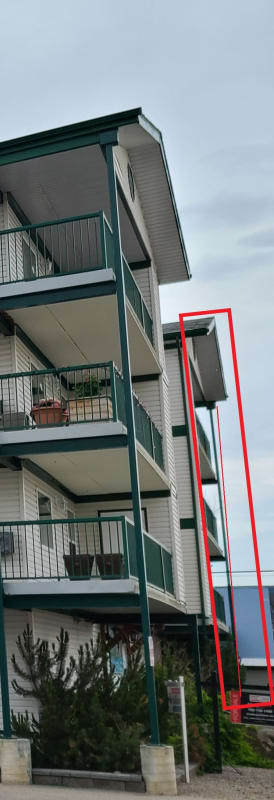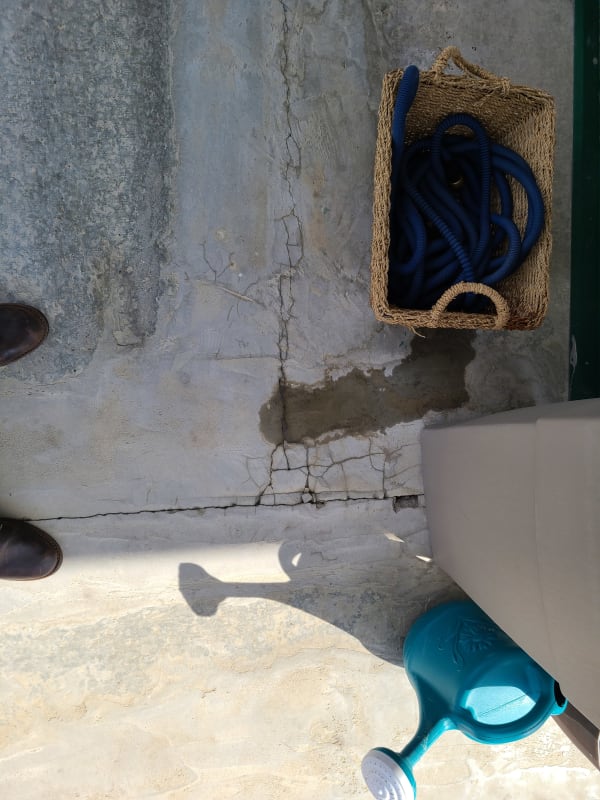I've been engaged by a nearby condominium board to investigate settlement and lateral deformation of their building. It is a 4-storey apartment-style condominium building. Parkade on the ground level, and three floors of living space above. Inconveniently, their record drawings are complete except for the structural drawings, and I have gone on a wild goose chase for those with no luck (EOR is retired, firm that bought his company doesn't have his records, town has nothing, province has nothing). Building was constructed in 2006-2007.
The structural system is:
Main Floor: Slab on grade parkade, wood framed exterior walls.
2nd Floor: Steel transfer girders supporting 8" Hollowcore
3rd & 4th Floors: 8" Hollowcore on wood framed walls
Roof: Light wood trusses, gabled roof on wood framed walls.
Balconies are supported on exterior steel columns. There are slope issues due to building settlement.
This is the first time that I have personally seen hollowcore on wood studs. To be honest, I am skeptical that it will work out math-wise due to the dead load of the floor system. The residents have noticed some problematic vertical and lateral deflections. The vertical deflections are likely sensible given the wood bearing walls' propensity to settle with shrinkage (crushing?) of plates and is mainly a serviceability issue. The lateral deformation noted is excessive in some cases (up to H/200 as measured with a plumb bob on exterior columns) and I have concerns for the relatively heavy floors to cause ongoing P-Delta lateral deformation.
Without the structural drawings, I am having difficulty assessing the lateral load system for the building. Photographs taken during construction seem to indicate intermittent, discrete diagonal wood bracing in the party walls between units (diagonals at spaced approximately 24" apart). Exterior walls are sheathed, but no hold-down devices are in the photographs and the panel lengths are quite short, leading me to doubt their effectiveness. Overall, a very odd building and an odd combination of materials.
Questions:
- Are there any resources for design with hollowcore on wood stud? My Google-fu might not be working today, but I have not turned up much.
- Does anyone have a good resource for evaluating wood shear walls with discrete diagonal bracing? I have not gone through this myself and CSA O86 only covers diagonal sheathing rather than the intermittent bracing that I am facing.
- Can I get a confirmation on my concern with the degree of out-of-plumb on the exterior columns? To me, anything over H/500 is worrying. The NBCC commentaries state that rotation greater than H/150 can result in ultimate limit states being reached, and this building appears to be not far away from that value.
- Interestingly, there is little evidence of distress inside the building where walls are finished with drywall throughout. This has me perplexed, as the deformation of the exterior columns was apparent from the street. Would H/200 (total and inter-storey) racking deflection not result in cracking of drywall at the joints?
The structural system is:
Main Floor: Slab on grade parkade, wood framed exterior walls.
2nd Floor: Steel transfer girders supporting 8" Hollowcore
3rd & 4th Floors: 8" Hollowcore on wood framed walls
Roof: Light wood trusses, gabled roof on wood framed walls.
Balconies are supported on exterior steel columns. There are slope issues due to building settlement.
This is the first time that I have personally seen hollowcore on wood studs. To be honest, I am skeptical that it will work out math-wise due to the dead load of the floor system. The residents have noticed some problematic vertical and lateral deflections. The vertical deflections are likely sensible given the wood bearing walls' propensity to settle with shrinkage (crushing?) of plates and is mainly a serviceability issue. The lateral deformation noted is excessive in some cases (up to H/200 as measured with a plumb bob on exterior columns) and I have concerns for the relatively heavy floors to cause ongoing P-Delta lateral deformation.
Without the structural drawings, I am having difficulty assessing the lateral load system for the building. Photographs taken during construction seem to indicate intermittent, discrete diagonal wood bracing in the party walls between units (diagonals at spaced approximately 24" apart). Exterior walls are sheathed, but no hold-down devices are in the photographs and the panel lengths are quite short, leading me to doubt their effectiveness. Overall, a very odd building and an odd combination of materials.
Questions:
- Are there any resources for design with hollowcore on wood stud? My Google-fu might not be working today, but I have not turned up much.
- Does anyone have a good resource for evaluating wood shear walls with discrete diagonal bracing? I have not gone through this myself and CSA O86 only covers diagonal sheathing rather than the intermittent bracing that I am facing.
- Can I get a confirmation on my concern with the degree of out-of-plumb on the exterior columns? To me, anything over H/500 is worrying. The NBCC commentaries state that rotation greater than H/150 can result in ultimate limit states being reached, and this building appears to be not far away from that value.
- Interestingly, there is little evidence of distress inside the building where walls are finished with drywall throughout. This has me perplexed, as the deformation of the exterior columns was apparent from the street. Would H/200 (total and inter-storey) racking deflection not result in cracking of drywall at the joints?


